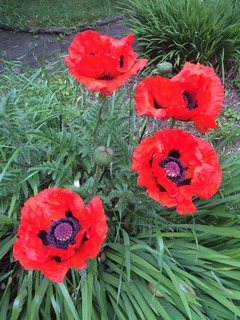What About Poppies: Powerful, Passionate, and Perilous Beauty
A Flower Steeped in Symbolism
There's something enchanting about poppies. They sway in the breeze like tissue paper flames, vibrant and fleeting. As an artist, I'm naturally drawn to things that hold emotion, history, and beauty all in one delicate package, and poppies deliver on all fronts.
While many poppies are simply grown for their ornamental beauty, some serve more practical roles. The opium poppy, Papaver somniferum, is perhaps the most famous. It's used to produce opiates for pain relief, as well as poppy seeds for baking and a deliciously nutty oil. But for me a New Zealand artist, the intrigue lies in their symbolism for art and the powerful stories they tell.
Types of Poppies – A Colourful Cast of Characters
Not all poppies are created equal. They come in many shapes, sizes, and colours, each with their own personality, just like us, really! Here are some of the most recognisable poppy types and what sets them apart:
Papaver rhoeas – The Corn Poppy
- AKA: Flanders Poppy, Remembrance Poppy
- Colour: Brilliant red
- Symbolism: Most associated with ANZAC Day and World War I remembrance, a huge part of my country, New Zealand.
- Interesting Fact: Grows easily in disturbed soil—like the churned-up earth of battlefields
Papaver somniferum – The Opium Poppy
- Colour: White, purple, pink or red
- Uses: Source of opium, morphine, codeine; also poppy seeds and oil for cooking
- Note: Due to its narcotic properties, it's strictly controlled in many countries
Papaver nudicaule – The Iceland Poppy
- Colour: White, yellow, orange, and pink
- Style: Delicate, almost translucent petals; frost-hardy and bright
- Popular In: Garden beds and cottage gardens
Eschscholzia californica – The California Poppy
- Colour: Bright orange and yellow
- Symbolism: The state flower of California symbolising sleep and peace
- Fun Fact: Technically, it is not a true poppy from the Papaver genus, but is equally adored
Meconopsis – The Himalayan Blue Poppy
- Colour: Striking blue (a rarity in nature!)
- Growing Needs: Cool, damp climates – a bit of a diva in the garden
- Loved For: Its ethereal, otherworldly beauty
Each poppy has its own magic. From the fiery Corn Poppy to the dreamlike Blue Himalayan, they each carry their own kind of poetry, and that's a dream come true for a painter like me.

Poppies in Art – More Than Just a Pretty Face
Let's be honest, poppy paintings sell. I've seen them practically fly off the walls at galleries and exhibitions. People are drawn to them. Maybe it's the bold burst of red, or maybe it's something deeper that resonates emotionally.
I have a friend, an amazing artist, who paints poppies almost exclusively. Her work has a beautiful softness and sincerity to it, yet she'll tell you she finds them boring. Funny thing is, collectors can't get enough. She gets commissions, prints, licensing deals... Her "boring" poppies are paying the bills and then some.
Why do poppies have such pulling power in the art world?

Here's my take:
They're instantly recognisable – even abstract versions are unmistakable.
They symbolise emotion – from love and loss to peace and hope.
They have historical weight – especially here in New Zealand with our ANZAC commemorations.
They offer artistic freedom – a poppy can be painted loose and dreamy or sharp and graphic. There's room for every style.
They connect generations – your nan might love them, and so might your daughter.
I believe it's this mix of beauty, meaning, and memory that makes them so magnetic. There's a nostalgia to them, especially around ANZAC Day, where they go beyond mere flora and become sacred symbols.
Whether people realise it or not, a red poppy painting often taps into something deeper: remembrance, gratitude, and a quiet, solemn kind of pride.
Even in modern interior design, a splash of scarlet from a poppy painting can warm up a minimalistic room, bringing both colour and conversation into the space. I've created poppies in everything from dreamy acrylic abstracts to stylised pop art, and each one carries its own energy.
Poppies are more than flowers, they're visual poetry.
ANZAC Poppies: Our National Emblem of Remembrance
In New Zealand and Australia, the red poppy holds sacred meaning. We wear it on our lapels, tuck it behind our ears, and lay it down at memorials on April 25th, ANZAC Day.
This humble flower is a symbol of remembrance for those who served and fell in war. Its story traces back to the blood-soaked fields of Flanders, where they bloomed defiantly among the devastation. John McCrae's poem In Flanders Fields (see below) ensured they were never forgotten, and neither were the soldiers who lay beneath them.
When I paint poppies for ANZAC exhibitions or commissions, I do so with care. Every brushstroke is a tribute. These aren't just flowers, they're memories, and they deserve to be honoured.
In Flanders Fields
The Tall Poppy Conversation
Then, of course, there's the other kind of poppy we talk about in New Zealand, the tall ones. The "Tall Poppy Syndrome" is so deeply ingrained in our culture that it's become almost comical. But in truth, it's hurtful.
It's the idea that once someone gets "too successful," they need to be taken down a peg. Whether you're an artist gaining recognition, a business owner doing well, or even just someone proud of your achievements, you risk becoming a target for criticism.

But isn't that exactly what tall poppies should do? Rise above. Stand tall. Inspire others to grow.
I've felt the sting of this syndrome, and I know many others who have, too. Artists, in particular, don't seem to want to boost one another, particularly if they feel threatened by another who they see as a competitor to their sales and let's face it, most artists live on the smell of an oily rag.
Still I think supporting one another instead would be much more beneficial. But I also believe we're shifting. More and more, I see Kiwis supporting each other and lifting each other up in general, and I love that.
Let the tall poppies bloom. Let us all bloom.
In Full Bloom
To me, poppies are about resilience. They grow in the harshest of soils. They show up where life has been lost. And somehow, they still manage to be breathtakingly beautiful.
In my art, I use them to tell stories, of memory, loss, hope, and renewal. Whether I'm creating a bold, graphic piece or a soft, impressionistic work, I know I'm not just painting a flower. I'm honouring a symbol.
So here's to the poppies, wild and cultivated, fallen and rising, silent and shouting in colour. Long may they bloom, both in our gardens and in our hearts.
Posted: Saturday 26 June 2010
